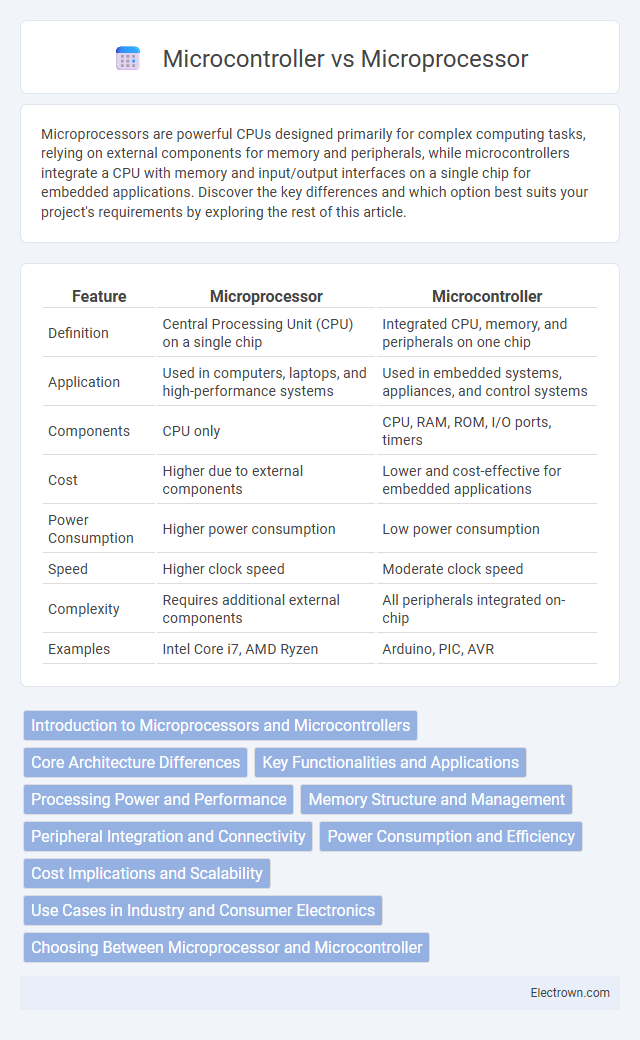Microprocessors are powerful CPUs designed primarily for complex computing tasks, relying on external components for memory and peripherals, while microcontrollers integrate a CPU with memory and input/output interfaces on a single chip for embedded applications. Discover the key differences and which option best suits your project's requirements by exploring the rest of this article.
Table of Comparison
| Feature | Microprocessor | Microcontroller |
|---|---|---|
| Definition | Central Processing Unit (CPU) on a single chip | Integrated CPU, memory, and peripherals on one chip |
| Application | Used in computers, laptops, and high-performance systems | Used in embedded systems, appliances, and control systems |
| Components | CPU only | CPU, RAM, ROM, I/O ports, timers |
| Cost | Higher due to external components | Lower and cost-effective for embedded applications |
| Power Consumption | Higher power consumption | Low power consumption |
| Speed | Higher clock speed | Moderate clock speed |
| Complexity | Requires additional external components | All peripherals integrated on-chip |
| Examples | Intel Core i7, AMD Ryzen | Arduino, PIC, AVR |
Introduction to Microprocessors and Microcontrollers
Microprocessors are central processing units designed to perform complex computations and control tasks in computers and high-performance systems, relying on external components like memory and peripherals. Microcontrollers integrate a processor core, memory, and input/output peripherals on a single chip, making them ideal for embedded applications in devices such as home appliances, automotive systems, and IoT gadgets. Understanding the key differences in architecture and functionality between microprocessors and microcontrollers helps optimize your choice for specific computing or control requirements.
Core Architecture Differences
Microprocessors feature a complex instruction set architecture (CISC) or reduced instruction set computer (RISC) design focused solely on processing power, lacking integrated peripherals and relying on external components for memory and I/O. Microcontrollers combine a CPU core with integrated memory (RAM and ROM), programmable I/O ports, and peripherals like ADCs or timers on a single chip, designed for dedicated control applications. The core architecture of microcontrollers emphasizes efficiency, low power consumption, and real-time processing capabilities, contrasting with the high computational throughput and flexibility of microprocessors.
Key Functionalities and Applications
Microprocessors feature high processing power and flexible memory management, making them ideal for complex computing tasks in personal computers and servers. Microcontrollers integrate a CPU, memory, and peripherals on a single chip, optimizing them for embedded systems like automotive controls, home appliances, and IoT devices. Understanding the key functionalities allows you to select the right component based on your application's complexity and resource requirements.
Processing Power and Performance
Microprocessors typically offer higher processing power and performance due to their advanced CPU architectures and faster clock speeds, making them ideal for complex computing tasks and multitasking applications. Microcontrollers generally have lower processing power as they integrate a CPU with memory and peripherals on a single chip, optimized for real-time control and embedded systems. The performance difference is evident in microprocessors' ability to handle intensive software applications, whereas microcontrollers excel in power efficiency and dedicated control operations.
Memory Structure and Management
Microprocessors rely on separate external memory for program and data storage, offering flexible yet complex memory management through external RAM and ROM modules. Microcontrollers integrate on-chip memory, including ROM/Flash for code storage and RAM for data, enabling efficient, real-time processing within a compact architecture. Your choice between the two depends significantly on the memory requirements and management simplicity needed for your embedded system application.
Peripheral Integration and Connectivity
Microcontrollers integrate a wide range of peripherals such as ADCs, timers, serial communication interfaces (UART, SPI, I2C) directly on the chip, enabling compact and cost-effective designs for embedded applications. In contrast, microprocessors typically require external peripherals and connectivity modules, offering greater flexibility and higher processing power but increasing the complexity and size of your system. Choosing between a microcontroller and microprocessor depends on your need for integrated connectivity versus scalable performance and expandability.
Power Consumption and Efficiency
Microcontrollers are designed for low power consumption and high efficiency, making them ideal for battery-operated and embedded systems by integrating CPU, memory, and peripherals on a single chip. Microprocessors typically consume more power due to higher clock speeds and separate components, suited for complex computing tasks requiring greater processing capabilities. Efficiency in microcontrollers stems from specialized hardware and optimized instruction sets, whereas microprocessors rely on external memory and peripheral devices that increase overall power usage.
Cost Implications and Scalability
Microprocessors generally incur higher costs due to their need for external components like memory and peripherals, making them less cost-effective for small-scale, embedded applications. Microcontrollers offer integrated memory and peripherals, reducing overall system cost and simplifying scalability for mass production in embedded systems. Scalability in microcontrollers is enhanced through various models with differing processing power and features within a single family, while microprocessors require more complex system design for scaling.
Use Cases in Industry and Consumer Electronics
Microprocessors dominate in high-performance computing, servers, and advanced consumer electronics like smartphones and gaming consoles, where complex processing and multitasking are critical. Microcontrollers excel in embedded systems, industrial automation, household appliances, and IoT devices due to their integrated peripherals, low power consumption, and real-time control capabilities. Your choice between them hinges on whether your application demands extensive computational power or efficient, dedicated control functions.
Choosing Between Microprocessor and Microcontroller
Choosing between a microprocessor and a microcontroller depends on the complexity and control requirements of your project. Microprocessors offer higher processing power and are ideal for applications needing extensive computation and advanced operating systems, while microcontrollers provide integrated memory and peripherals for low-power, real-time control tasks. Your decision should consider factors like cost, embedded system integration, and power consumption to ensure optimal performance and efficiency.
Microprocessor vs Microcontroller Infographic

 electrown.com
electrown.com